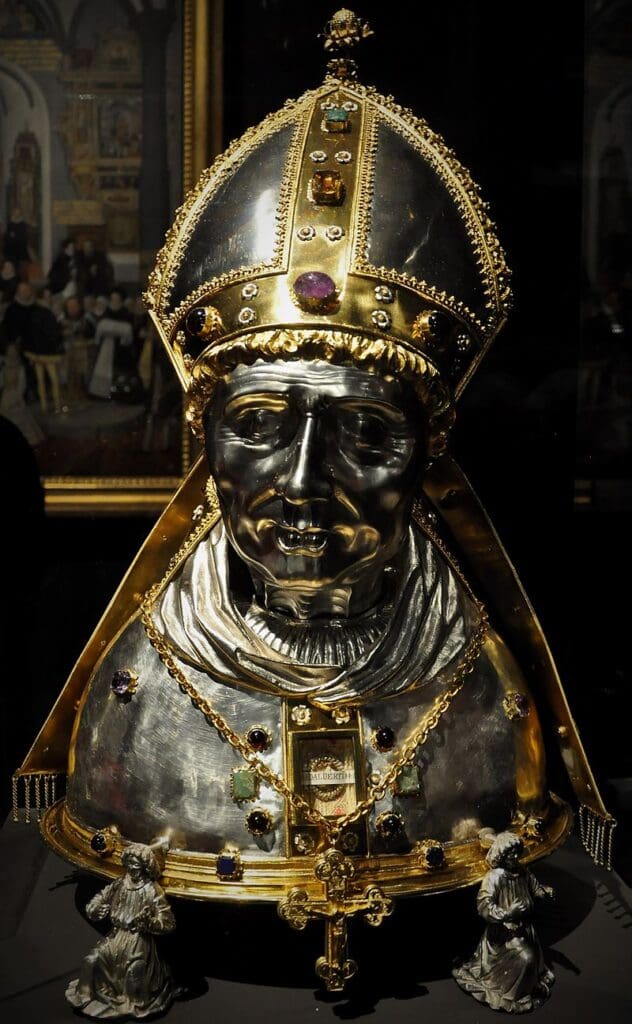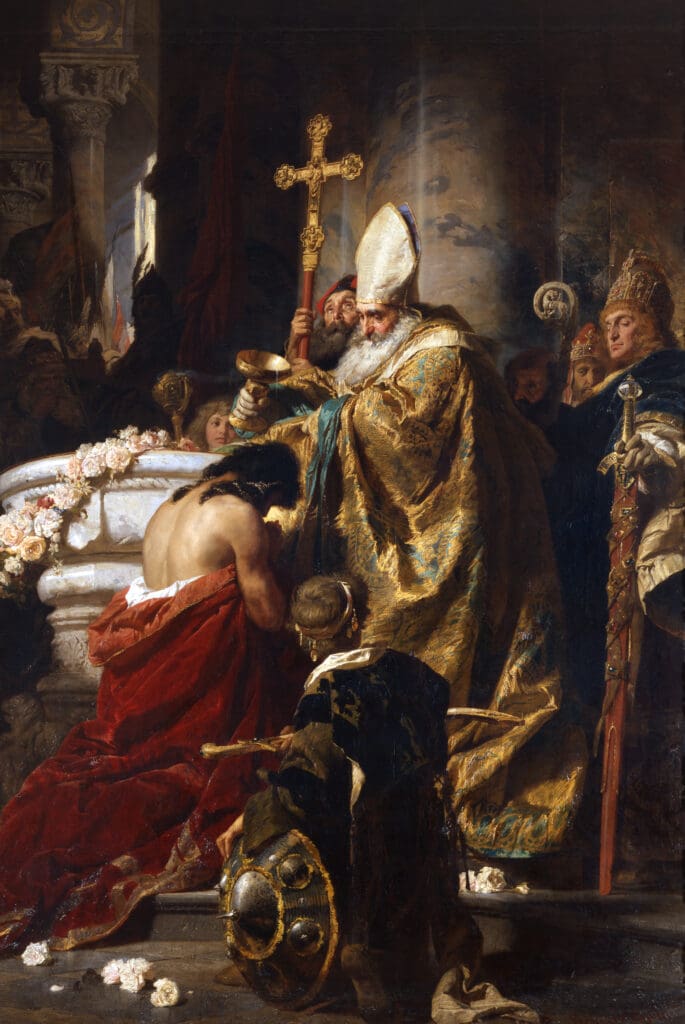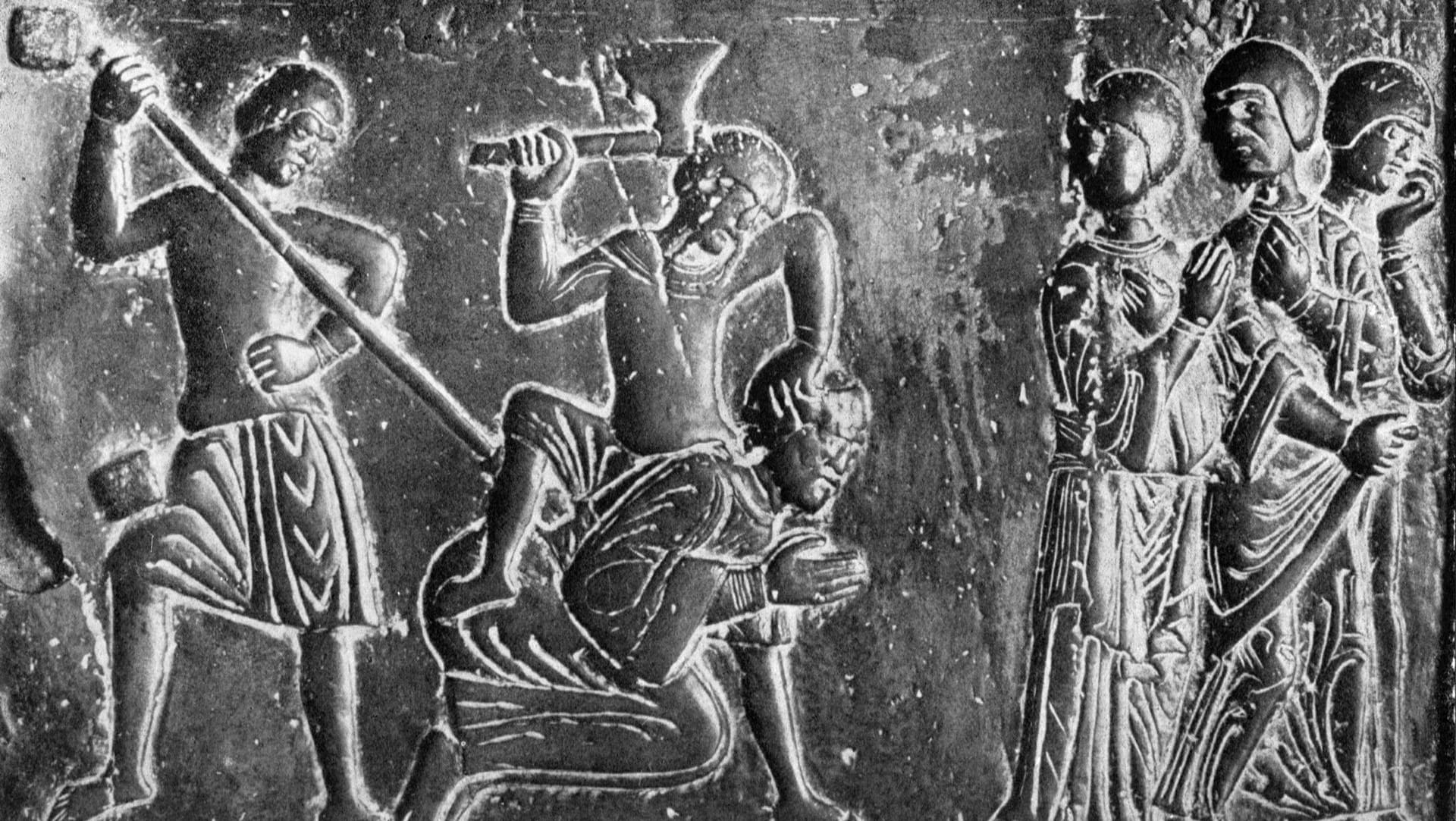If we look for George’s Day on 23 April in Czech, Slovak, Polish, or Hungarian calendars, we will be very surprised. In the earliest sacramentary of St Margaret of Hungary, circa 1100, George and Adalbert were celebrated on the same day, but later in the Central European calendars one of the most famous feasts of the Latin and Greek churches had to be deferred by a day to make room for Adalbert, Bishop of Prague.
Adalbert, who is also known by his original Slavic birth name Wojciech in Polish, Vojtěch in Czech, and Vojtech in Slovak, was the second bishop of Prague from 983. He received an excellent education at the imperial centre in Magdeburg, Germany, where he committed himself to the monastic reform movement. After taking over the bishopric of Prague in 983, he became involved in internal political struggles, had his relatives murdered, and had to flee his diocese twice, but remained in constant contact with the Pope throughout. In Rome, he entered the Monastery of St Boniface and Alexius on Mount Aventine (990–992), visited several other European centres, and became a close friend and adviser to Emperor Otto III and the Polish ruler Bolesław I the Brave (r. 992–1025). He died a martyr at the hands of the pagan Prussians in 997 in what is now the enclave of Kaliningrad and was buried in Gniezno, Poland, where the bronze door of the cathedral, completed by 1175 and still standing, depicts his legend in 18 scenes.[1]
Despite his tragic life, he left a lasting mark on European history. Otto III was deeply shocked by the death of Adalbert—he had him canonized by the Pope already in 999, and in 1000 his Lenten pilgrimage led him to the martyr’s tomb in Gniezno. Bolesław the Brave bought Adalbert’s body from the Prussians for as much gold as it weighed—this proved to be one of the most successful ‘deals’ in history. Otto’s visit to Poland was a milestone in Polish history, as it marked the foundation of an independent Polish archdiocese in Gniezno and the coronation of the then Prince Bolesław the Brave, namely, the birth of an independent Polish Kingdom. As a symbolic figure of Polish sovereignty,
Adalbert became the patron of the country and the legal basis of the independent Polish ecclesiastical organization,
along with St Stanislas and St Hedwig of Silesia. The crown was placed on Bolesław’s head by the Emperor himself, although his enigmatic words at the time, with which he made Bolesław a ‘brother and partner of the Empire’, are still being interpreted by historians.[2] The details are not known, but it is certain that Otto III wanted to encircle the German Empire with quasi-independent states with crowned monarchs, from Venice through Hungary and Bohemia to Poland.
Otto III established the veneration of Adalbert throughout the whole of Europe, founding churches of his relics in Aachen, Ravenna, Liège, and Reichenau, and placing his holy arm in the Church of San Bartolomeo in Rome. It is no coincidence that the Esztergom Basilica, the centre of the Hungarian archdiocese, founded in the same year 1000, was also dedicated to Adalbert, and thus his relics obviously found their way there as well. The election of Adalbert as patron of the first Hungarian archdiocese was a conscious choice of the Emperor. His figure is the one appearing next to that of King Stephen and the Virgin Mary on the tympanum of the 13th-century Porta Speciosa, the fragmentary portal of the Esztergom Basilica.

The Hungarian historical tradition linked the figures of St Adalbert and King Stephen very early on. In the Greater Legend of Stephen, written around 1083, two chapters are dedicated to the memory of Adalbert: according to this story, in a heavenly vision, it was announced to Prince Géza, Stephen’s father, ‘that the blessed Adalbert, prelate of the Bohemian Church, was coming to him for his instruction, and to ensure the progress of his unfeigned faith’. Legend has it that Adalbert’s stay in Hungary is a real success story: ‘Therefore, at the order of the ruler, the unruly people came together from all parts, the holy bishop made exhortations continuously, the people of the land were converted and baptized, and churches were established in many places.’ Stephen I was born in the meantime, and ‘Bishop Adalbert, beloved by God, anointed him with the baptismal chrism according to his true faith and was his sponsor. The name Stephen was given him, which we do not believe to have been contrary to the purpose of God’.[3] Adalbert’s visit to Hungary raises several chronological problems that modern scholarship still struggles with. It has been suggested, for example, that Adalbert did not baptize Stephen, but confirmed him. According to later German tradition, he might have played a role in preparing the marriage between the German Emperor Henry II’s sister Gisela and Stephen. However, there was no doubt in the mind of medieval man that
Adalbert had put his stamp on the beginnings of the domestic church organization, and he baptized St Stephen,
and perhaps even his father Géza. His legends, along with the quotations above, became part of the liturgical reading, and every cleric who knew Latin knew them by heart.
In 1875, a painting by the celebrated Hungarian painter Gyula Benczúr summed up all the elements of the fictional historical tradition, which included Adalbert, the adult Stephen, reluctant to accept baptism, Emperor Otto III, and the Duke of Bavaria. What is certain is that these characters never met together in this way, much less were they present at Stephen’s baptism ceremony, which is not even known from the sources. Unfortunately, the biographies of Adalbert tell us almost nothing about his stay in Hungary and its merits. According to these sources, ‘sometimes he sent his envoys, sometimes he went to the Hungarians himself…and, after having somewhat removed them from sin, he cast the shadow of Christianity over them’. According to contemporary Christian missionary bishop Bruno of Querfurt, the semi-Christian conditions at Prince Géza’s court, ‘the idle and languid Christianity’, were worse than paganism itself. The legends of Stephen probably exaggerate Adalbert’s successes in Hungary, perhaps in order to completely erase the memory of the German conversion under Otto III from the pages of the Hungarian chronicles.

In Adalbert’s biography, it is understandable why his visit to Hungary after his departure from Prague in 994 is recorded in only one or two lines, for it did not add much to his life and the holiness he was to achieve. On the contrary, it was Adalbert who raised King Stephen’s prestige, prepared the way for his sainthood, and became a decisive figure in his legend. Whatever Adalbert’s connection with Hungary during his life,
after his death, his relics and veneration made him a decisive saint of Hungarian Christianity, and he remains so to this day.
Adalbert’s veneration in Bohemia was peculiar, as none of his bodily relics made it to Prague, even though he was its bishop, and in 993 he founded the first male monastery in Břevnov, a district in Prague, to which he probably brought with him several relics, liturgical books, and clothing from Rome. However, in 1039/40, during the long-running Czech–Polish wars, the Czech Prince Břetislav I looted Gniezno, taking with him the relics, including those of Adalbert, his brother, the first Archbishop of Gniezno, as well as other treasures. The relics were soon deposited in the St Vitus Cathedral of the Prague Castle, where Adalbert became the second patron saint of the kingdom, alongside St Wenceslaus. The saint’s relics were also carried into war, such as the Battle of Kressenbrunn in 1260, where the Czechs defeated the Hungarians, who also had Adalbert as one of their patron saints. Even the fact that the Poles unexpectedly found Adalbert’s relics in Gniezno in 1127 and placed them on an altar did not detract from his veneration, as they believed that the Czechs had not completely removed his relics in 1039/40.[4]
Posterity is not ungrateful to the memory of St Adalbert—in 1997, for example, on the millennium of his death, Pope John Paul II visited Gniezno. He is considered an early representative of today’s united Europe, and prizes have been founded in his name in Prague, Bratislava, and Esztergom. The rapid medieval rise of the then peripheral ‘New Europe’ within Latin Christianity is embodied by the exceptional personality of Vojtěch, that is, Adalbert. It was Adalbert and his inseparable Emperor Otto III who left an unmistakable mark on the history of Central Europe after 1000. Politics permeated Adalbert’s tragic life as much as the birth of the then-nascent and emerging states of Poland, Bohemia, and Hungary. That is the way Adalbert became the patron saint of all three Central and Eastern European Kingdoms, helping them to preserve their independence and join medieval Europe as autonomous Christian communities.
This is why his figure still unites Czechs, Poles, Hungarians, and Slovaks to this very day.
[1] Ian Wood, The Missionary Life: Saints and the Evangelisation of Europe, 400–1050, Harlow, 2001, pp. 226–244.
[2] Johannes Fried, Otto III. und Boleslaw Chrobry, Stuttgart, 2001.
[3] ‘Life of King Saint Stephen (Greater Legend)’, transl. by Cristian Gaşpar, in The Sanctity of the Leaders. Holy Kings, Bishops, and Abbots from Central Europe, Eleventh to Thirteenth Centuries (eds. Gábor Klaniczay, Ildikó Csepregi, et al.), Budapest, New York, Vienna, 2023, pp. 47–49.
[4] Gábor Klaniczay, ‘Saints’ Cults in Medieval Central Europe: Rivalries and Alliances’, in Nils Holger Petersen, Anu Mänd, et al. (eds.), Symbolic Identity and the Cultural Memory of Saints, Newcastle upon Tyne, 2018, pp. 22–27.
Related articles:








